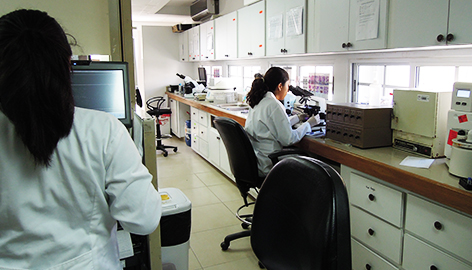GLI Belice
GLI Belice
Belice
- Beneficiarios directos · 16.000 de personas de los distritos Toledo i Stann Creek
- Beneficiarios indirectos · 76.000 de personas de los distritos Toledo i Stann Creek
El GLI Belice se inició en 2017 con la finalidad de fortalecer las capacidades médicas de los laboratorios del sistema público de salud del país. Concretamente se actúa en los laboratorios de los Hospitales, Dangriga, (en el distrito de Stann Creek), en los centros de salud de San Antonio y Santa Theresa (en el distrito de Toledo)y en los centros de salud de Chunox y San Narciso en el norte del país. Este programa se lleva a cabo conjuntamente con UNICEF España, UNICEF Belice y el Ministerio de Salud de Belice

Contexto e indicadores de salud
Belice se sitúa en la costa este de América Central, con fronteras al norte con México y al sur y oeste con Guatemala. Cuenta con una población de 344.000 personas, de entre las cuales 3 de cada 5 es menor de 25 años (58%). Con una superficie de 23.000 km2 Belice es uno de los países con menor densidad de población del mundo.
El año 2009 se realizó el último análisis sobre situación de pobreza en el país. Según dichos datos, el 41,3% de la población vive en pobreza extrema, con unas condiciones insatisfactorias de salud y casi la mitad de este grupo (15,8%) son indigentes (personas que carecen de medios para comprar comida). Los niveles de pobreza en las zonas rurales son dos veces superiores (43%) respecto a las detectadas en las zonas urbanas (21%). En los distritos de Toledo y Stann Creek la tasa de pobreza es del 46% y el 32%, respectivamente. Algunos de los indicadores de salud más relevante del país son los siguientes:
- En el distrito de Toledo el porcentaje de niños y niñas sin vacunar es superior a la media nacional: 7% en el distrito respecto al 4,7% del nivel nacional.
- La desnutrición crónica afecta al 17,5% de los menores que viven en zonas rurales y al 33,2% de los niños y niñas que residen en las zonas sureñas del distrito de Toledo.
- Sólo el 33,2% de los bebés reciben lactancia materna (práctica que se quiere impulsar).
- Se estima que la tasa de prevalencia del VIH es del 1,4% entre la población de 15 a 49 años, siendo elnúmero de hombres que viven con VIH50% superior que el de mujeres.
Los objetivos del proyecto
Principalmente, se quiere mejorar la capacidad del país para la detección temprana y el diagnóstico preciso y garantizar el manejo médico adecuado de las enfermedades. Además, se ponen como retos:
- Mejorar las capacidades de 3 laboratorios del sud de Belize (Dangriga. San Antonio y Santa Theresa) para que puedan ofrecer un servicio médico adaptado a las necesidades de los habitantes de esas áreas.
- Incrementar las habilidades del personal de laboratorio y los médicos proporcionando servicios a la población más vulnerable [materna e infantil] durante los períodos más críticos del embarazo, el parto y el período posnatal.
Los impactos del proyecto
Actualmente ya se han mejorado las infraestructuras de todos los laboratorios, se han equipado con lo necesario y nos encontramos en la segunda fase de formación de los técnicos de los laboratorios del norte.
Los beneficios que aportará del GLI Belize para la población usuaria de los laboratorios y el hospital y centros de salud son, entre algunos, reducción del tiempo de espera de los resultados de las pruebas de laboratorio, mejora de la calidad de los resultados, así como también del diagnóstico, y reducción de los costes.
En referencia a los beneficiarios directos del proyecto se estiman unas 16.000 personas de los distritos de Toledo y Stann Creek. De éstos, 11.500 son mujeres y 3.850 son niños y niñas menores de 15 años. Los beneficiarios indirectos del proyecto son 76.000 personas aproximadamente, 37.600 de éstas mujeres y 27.000 niños y niñas menores de 15 años.
Cabe destacar que una implementación satisfactoria de cada una de las acciones del proyecto incrementará las capacidades técnicas de los laboratorios y puede estimular el interés de donantes potenciales y seguir reforzando el servicio médico de Belize.
Des de que se implementó el GLI-Belize, el nuevo laboratorio de Dangriga ha doblado el número de pruebas realizadas y en el laboratorio de San Antonio la obtención de resultados se ha reducido de 72 horas a 12 horas.
Gracias al impacto del GLI el Ministerio de Salud se plantea la inclusión de laboratorios de diagnóstico en centros de salud de comunidades remotas.
In association with: UNICEF
